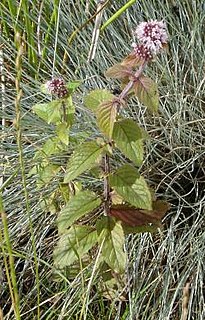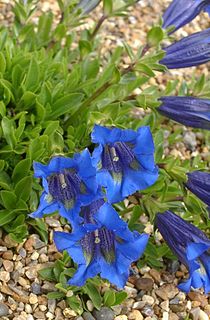
Nepeta is a genus of flowering plants in the family Lamiaceae. The genus name is reportedly in reference to Nepete, an ancient Etruscan city. There are about 250 species.

Mentha is a genus of plants in the family Lamiaceae. The exact distinction between species is unclear; it is estimated that 13 to 24 species exist. Hybridization occurs naturally where some species' ranges overlap. Many hybrids and cultivars are known.

The Cyperaceae are a family of graminoid (grass-like), monocotyledonous flowering plants known as sedges. The family is large, with some 5,500 known species described in about 90 genera, the largest being the "true sedges" genus Carex with over 2,000 species.

Mentha aquatica is a perennial flowering plant in the mint family Lamiaceae. It grows in moist places and is native to much of Europe, northwest Africa and southwest Asia.

Gentianaceae is a family of flowering plants of 103 genera and about 1600 species.

Pilularia or pillworts is a genus of unusual ferns of family Marsileaceae distributed in North Temperate regions, Ethiopian mountains, and the southern hemisphere in Australia, New Zealand, and western South America.

Lomandroideae is a subfamily of monocot flowering plants in the family Asparagaceae, order Asparagales, according to the APG III system of 2009. The subfamily name is derived from the generic name of the type genus, Lomandra. The group has previously been treated as a separate family Laxmanniaceae. In the Kubitzki system, it is treated as Lomandraceae Lotsy.

Lagochilus is a genus of the mint family that contains Turkistan mint.

Andira is a genus of flowering plants in the legume family, Fabaceae. It is distributed in the tropical Americas, except for A. inermis, which also occurs in Africa. It was formerly assigned to the tribe Dalbergieae, but recent molecular phylogenetic evidence has placed it in a unique clade named the Andira clade.

Linderniaceae is a family of flowering plants in the order Lamiales, which consists of about 25 genera and 265 species occurring worldwide. Vandellia micrantha is eaten in Laos, but tastes bitter. Best known are the wishbone flowers Torenia fournieri and Torenia thouarsii, which are used as bedding plants especially in the tropics. Micranthemum is sold as an aquarium plant when it is called 'baby tears'.

Hypenia is a genus of flowering plants in the mint family, Lamiaceae, first described as a genus in 1988. It is native to South America and southern Mexico.
- Hypenia aristulata(Epling) Harley - Goiás
- Hypenia brachystachys(Pohl ex Benth.) Harley - southern Brazil
- Hypenia calycina(Pohl ex Benth.) Harley - Brazil
- Hypenia concinna(Benth.) Harley - Tocantins
- Hypenia crispata(Pohl ex Benth.) Harley - Goiás
- Hypenia densiflora(Pohl ex Benth.) Harley - Brazil
- Hypenia durifolia(Epling) Harley - Brazil
- Hypenia gardneriana(Benth.) Harley - Brazil
- Hypenia glauca(A.St.-Hil. ex Benth.) Harley - Brazil, Paraguay
- Hypenia inelegans(Epling) Harley - Brazil
- Hypenia irregularis(Benth.) Harley - Brazil
- Hypenia macrantha(A.St.-Hil. ex Benth.) Harley - Brazil
- Hypenia macrosiphon(Briq.) Harley - Brazil, Paraguay, Bolivia
- Hypenia marifolia(Benth.) Harley - Brazil
- Hypenia micrantha(Benth.) Harley - Mato Grosso
- Hypenia paniculata(Benth.) Harley - Brazil
- Hypenia paradisi(Harley) Harley - Goiás
- Hypenia pauliana(Epling) Harley - Brazil
- Hypenia perplexa(Epling) Harley - Brazil
- Hypenia pruinosa(Pohl ex Benth.) Harley - Brazil
- Hypenia reticulata(Mart. ex Benth.) Harley - eastern Brazil
- Hypenia salzmannii(Benth.) Harley - Brazil, Guyana, Venezuela
- Hypenia simplex(A.St.-Hil. ex Benth.) Harley & J.F.B.Pastore - Brazil
- Hypenia subrosea(Harley) Harley - Goiás
- Hypenia violaceaMart.Gord. & S.Valencia - Guerrero, Oaxaca
Mentha darvasica is a mint species within the genus Mentha, native to Darvaz, Tajikistan. The species was recorded by Russian botanist Antonina Borissova in 1954.
Mentha alaica is a mint species within the genus Mentha, native to the Pamir-Alay mountain range within Tajikistan and Kyrgyzstan. The species was recorded by Russian botanist Antonina Borissova in 1954.
Mentha pamiroalaica is a mint species within the genus Mentha, endemic to the Gissar Range in Tajikistan. The species was recorded by Russian botanist Antonina Borissova in 1954.

Mentha cunninghamii, known commonly as New Zealand mint or Māori mint, is a species within the Mentha (mint) genus, endemic to four islands in New Zealand.

Mentha gattefossei is a plant species in the genus Mentha, endemic to the Atlas Mountains of Morocco. It was first described by French botanist René Maire in 1922. Harvested for its essential oil, M. gattefossei has seen use in traditional medicine, pest control and as a food seasoning.
Mentha japonica is a plant species in the genus Mentha, endemic to the islands of Hokkaido and Honshu, Japan. Initially described as Micromeria japonica by Friedrich Anton Wilhelm Miquel, it was first identified under its present name by Japanese botanist Tomitaro Makino in 1906. A relatively rare plant, it is classified by the Japanese Ministry of Environment as a Near Threatened species.
Mentha grandiflora is a plant species in the genus Mentha, endemic to eastern Australia. The species was described in 1848 by botanist George Bentham. Its epithet, grandiflora, means "with large flowers".












